Abstract
Harada, Kenji (Gunma University, Maebashi, Japan), Mitsuo Kameda, Mitsue Suzuki, and Susumu Mitsuhashi. Drug resistance of enteric bacteria. II. Transduction of transmissible drug-resistance (R) factors with phage epsilon. J. Bacteriol. 86:1332–1338. 1963.—Transmissible drug-resistance (R) factors, which transfer resistance to tetracycline (TC), chloramphenicol, streptomycin, and sulfonamide by cell-to-cell contact, were found to be transduced in the system of Salmonella E group with phage epsilon (ε15 and ε34). The R+ transductants of S. newington (S-84) and S. chittagong (S-224) were all found to be unable to transfer their R factors by conjugation, and their R factors were not eliminated by treatment with acridine dyes so far as tested. The R factors containing TC resistance were consistently segregated when transduced. At low multiplicities of infection, the R+ transductants with ε15 were all nonlysogenic and unable to produce normal ε15 phage particles; among the R+ transductants with ε34, 34% were lysogenic and 66% were sensitive to ε34.
Full text
PDF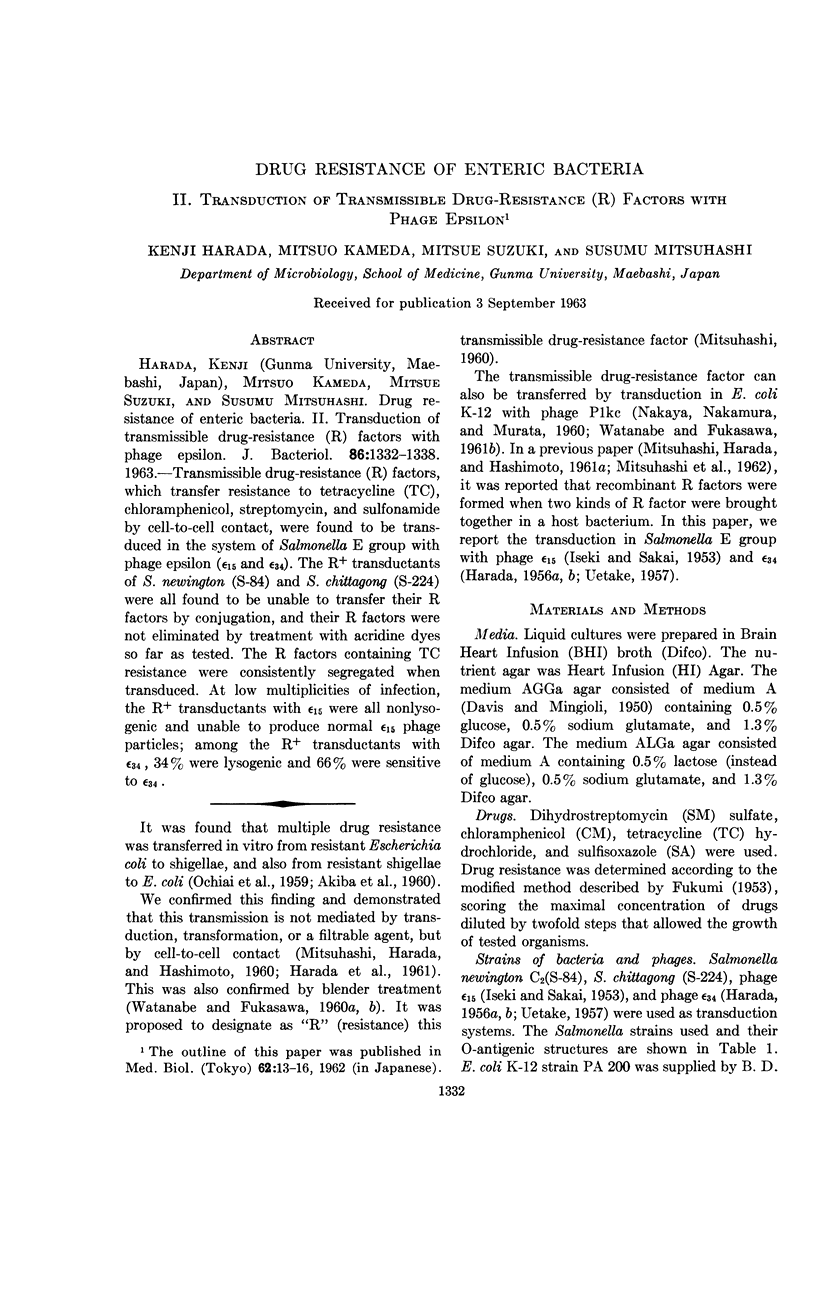
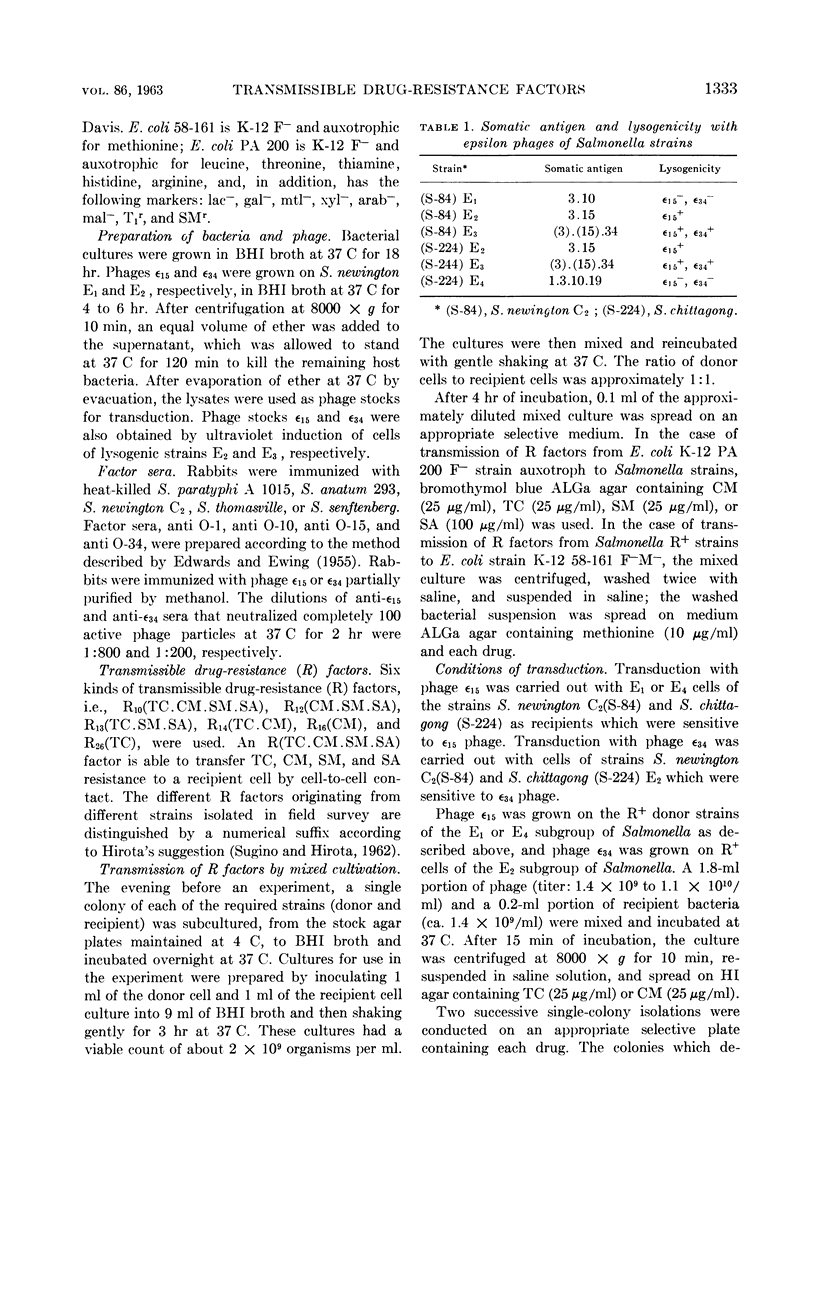
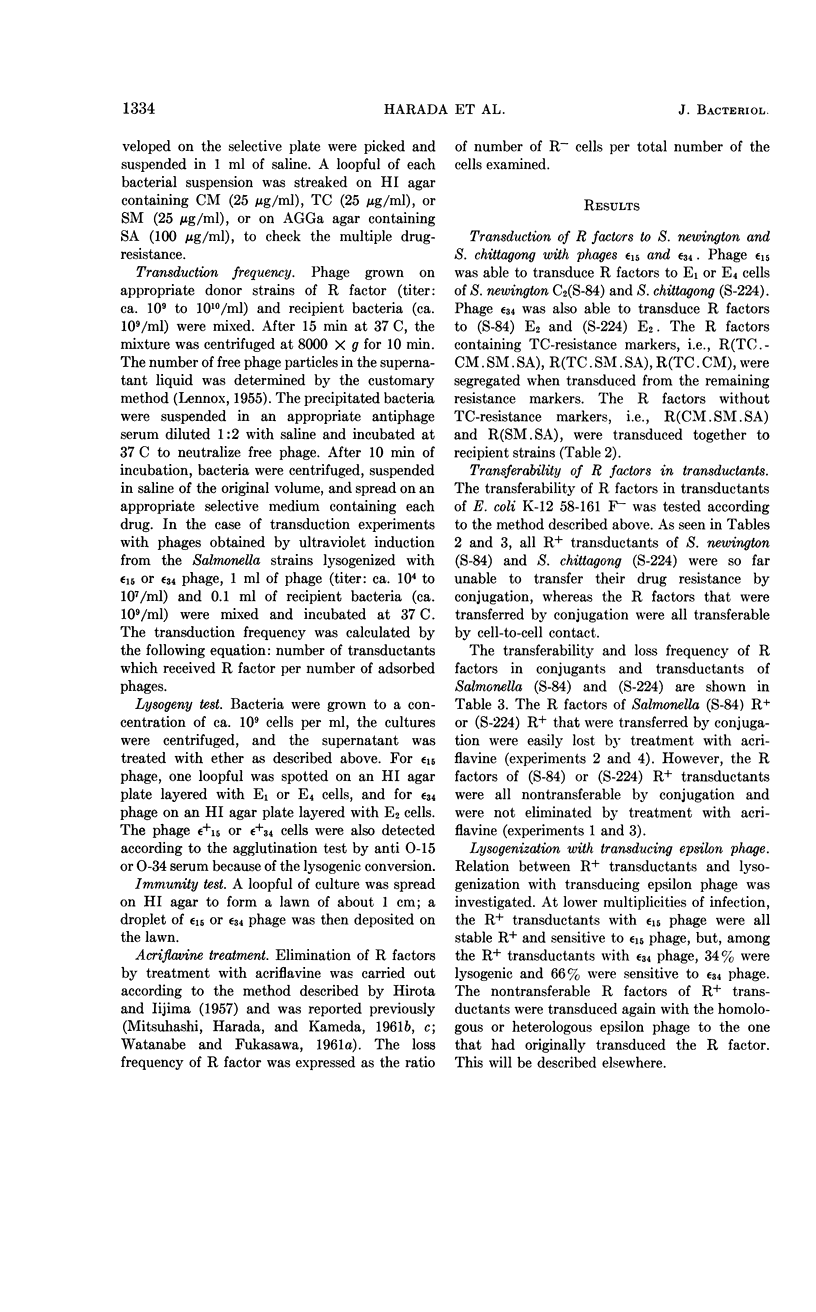

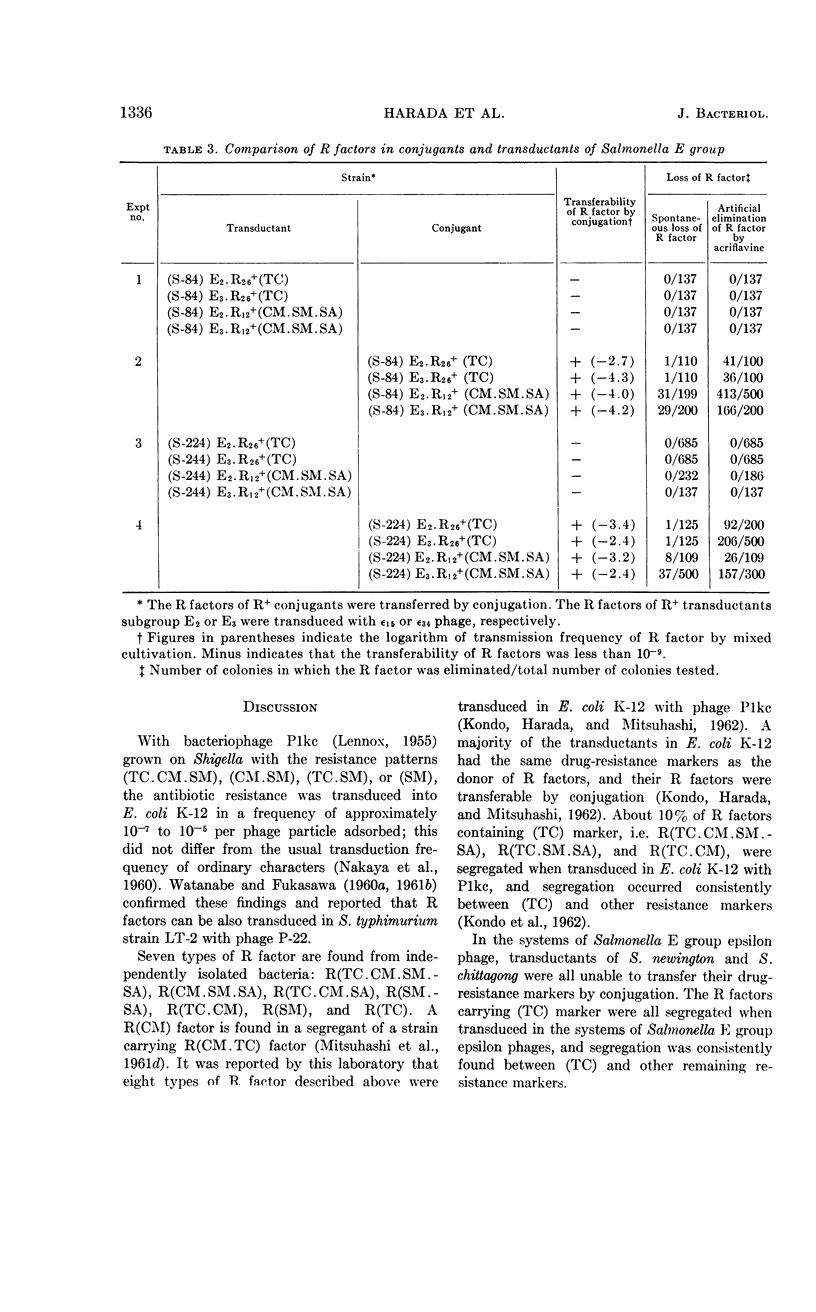
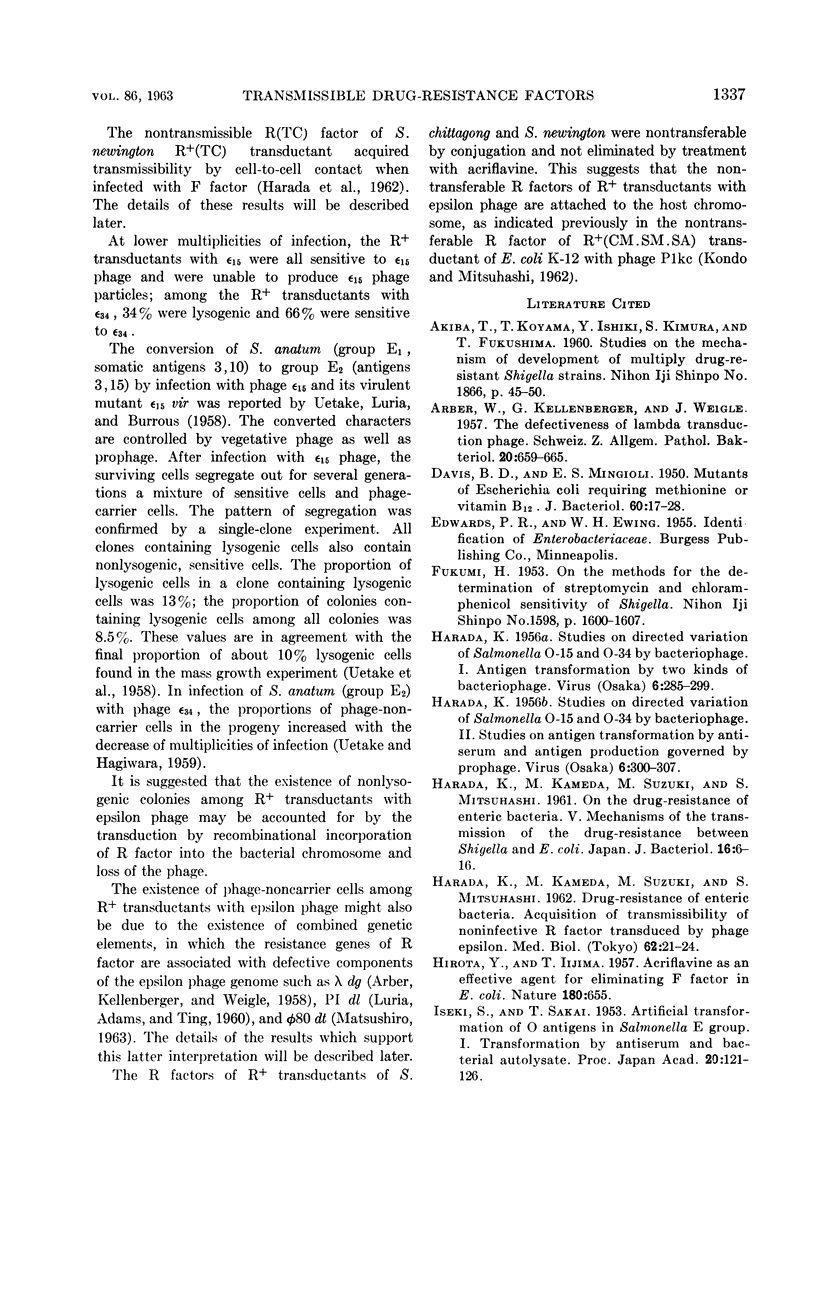
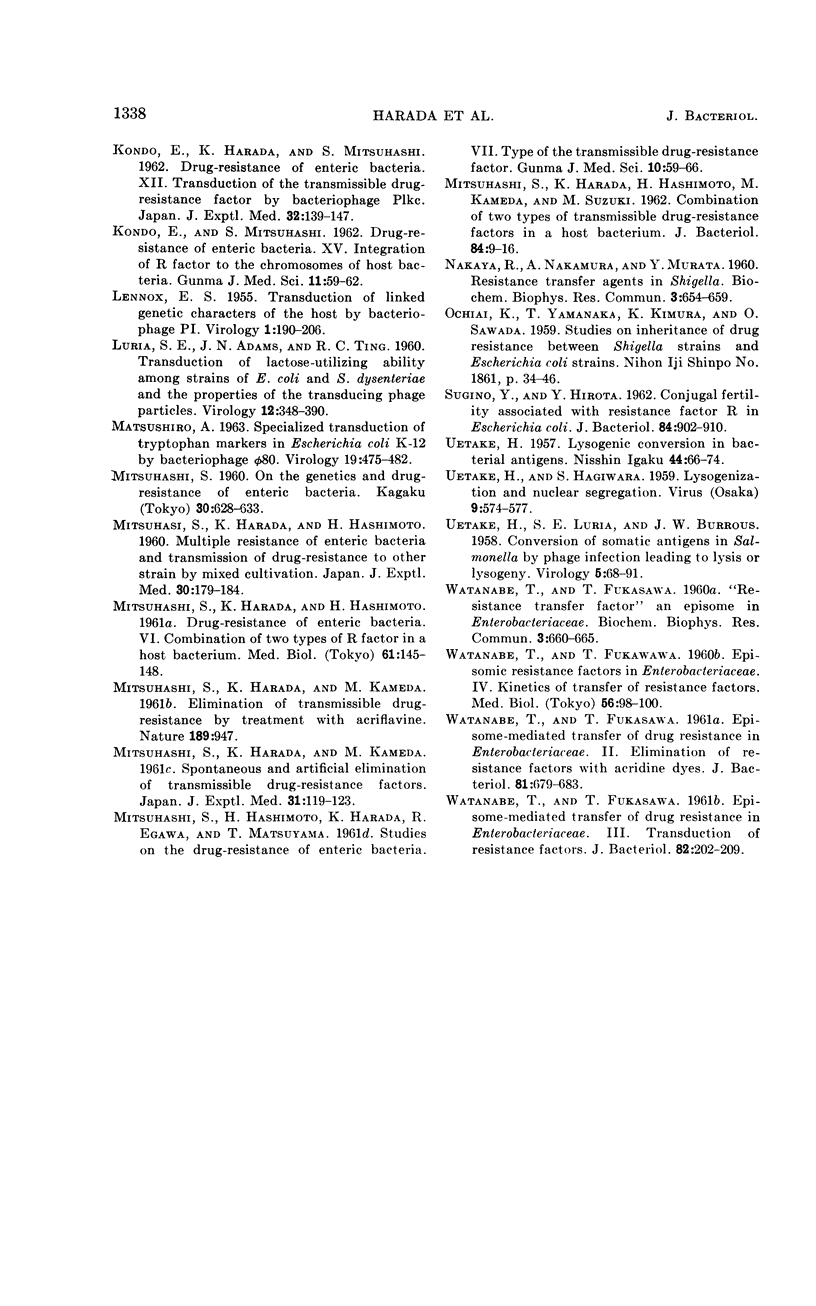
Selected References
These references are in PubMed. This may not be the complete list of references from this article.
- ARBER W., KELLENBERGER G., WEIGLE J. La défectuosité du phage lambda transducteur. Schweiz Z Pathol Bakteriol. 1957;20(5):659–665. [PubMed] [Google Scholar]
- DAVIS B. D., MINGIOLI E. S. Mutants of Escherichia coli requiring methionine or vitamin B12. J Bacteriol. 1950 Jul;60(1):17–28. doi: 10.1128/jb.60.1.17-28.1950. [DOI] [PMC free article] [PubMed] [Google Scholar]
- HARADA K., KAMEDA M., SUZUKI M., MITSUHASHI S. [On the drug resistance of enteric bacteria. 5. Mechanisms of the transmission of drug resistance between Shigella and E. coli]. Nihon Saikingaku Zasshi. 1961 Jan;16:6–16. doi: 10.3412/jsb.16.6. [DOI] [PubMed] [Google Scholar]
- HIROTA Y., LIJIMA T. Acriflavine as an effective agent for eliminating F-factor in Escherichia coli K-12. Nature. 1957 Sep 28;180(4587):655–656. doi: 10.1038/180655a0. [DOI] [PubMed] [Google Scholar]
- KONDO E., HARADA K., MITSUHASHI S. Drug-resistance of enteric bacteria. 12. Transduction of the transmissible drug resistance factor by bacteriophage Plkc. Jpn J Exp Med. 1962 Feb;32:139–147. [PubMed] [Google Scholar]
- LENNOX E. S. Transduction of linked genetic characters of the host by bacteriophage P1. Virology. 1955 Jul;1(2):190–206. doi: 10.1016/0042-6822(55)90016-7. [DOI] [PubMed] [Google Scholar]
- LURIA S. E., ADAMS J. N., TING R. C. Transduction of lactose-utilizing ability among strains of E. coli and S. dysenteriae and the properties of the transducing phage particles. Virology. 1960 Nov;12:348–390. doi: 10.1016/0042-6822(60)90161-6. [DOI] [PubMed] [Google Scholar]
- MATSUSHIRO A. Specialized transduction of tryptophan markers in Escherichia coli K12 by bacteriophage phi-80. Virology. 1963 Apr;19:475–482. doi: 10.1016/0042-6822(63)90041-2. [DOI] [PubMed] [Google Scholar]
- MITSUHASHI S., HARADA K., HASHIMOTO H., KAMEDA M., SUZUKI M. Combination of two types of transmissible drug-resistance factors in a host bacterium. J Bacteriol. 1962 Jul;84:9–16. doi: 10.1128/jb.84.1.9-16.1962. [DOI] [PMC free article] [PubMed] [Google Scholar]
- MITSUHASHI S., HARADA K., HASHIMOTO H. Multiple resistance of enteric bacteria and transmission of drug-resistance to other strain by mixed cultivation. Jpn J Exp Med. 1960 Jun;30:179–184. [PubMed] [Google Scholar]
- MITSUHASHI S., HARADA K., KAMEDA M. Elimination of transmissible drug-resistance by treatment with acriflavin. Nature. 1961 Mar 18;189:947–947. doi: 10.1038/189947a0. [DOI] [PubMed] [Google Scholar]
- MITSUHASHI S., HARADA K., KAMEDA M. On the drug-resistance of enteric bacteria. 6. Spontaneous and artificial elimination of transmissible drug-resistance factors. Jpn J Exp Med. 1961 Apr;31:119–123. [PubMed] [Google Scholar]
- NAKAYA R., NAKAMURA A., MURATA Y. Resistance transfer agents in Shigella. Biochem Biophys Res Commun. 1960 Dec;3:654–659. doi: 10.1016/0006-291x(60)90081-4. [DOI] [PubMed] [Google Scholar]
- SUGINO Y., HIROTA Y. Conjugal fertility associated with resistance factor R in Escherichia coli. J Bacteriol. 1962 Nov;84:902–910. doi: 10.1128/jb.84.5.902-910.1962. [DOI] [PMC free article] [PubMed] [Google Scholar]
- UETAKE H., LURIA S. E., BURROUS J. W. Conversion of somatic antigens in Salmonella by phage infection leading to lysis or lysogeny. Virology. 1958 Feb;5(1):68–91. doi: 10.1016/0042-6822(58)90006-0. [DOI] [PubMed] [Google Scholar]
- WATANABE T., FUKASAWA T. Episome-mediated transfer of drug resistance in Enterobacteriaceae. II. Elimination of resistance factors with acridine dyes. J Bacteriol. 1961 May;81:679–683. doi: 10.1128/jb.81.5.679-683.1961. [DOI] [PMC free article] [PubMed] [Google Scholar]
- WATANABE T., FUKASAWA T. Episome-mediated transfer of drug resistance in Enterobacteriaceae. III. Transduotion of resistance factors. J Bacteriol. 1961 Aug;82:202–209. doi: 10.1128/jb.82.2.202-209.1961. [DOI] [PMC free article] [PubMed] [Google Scholar]


